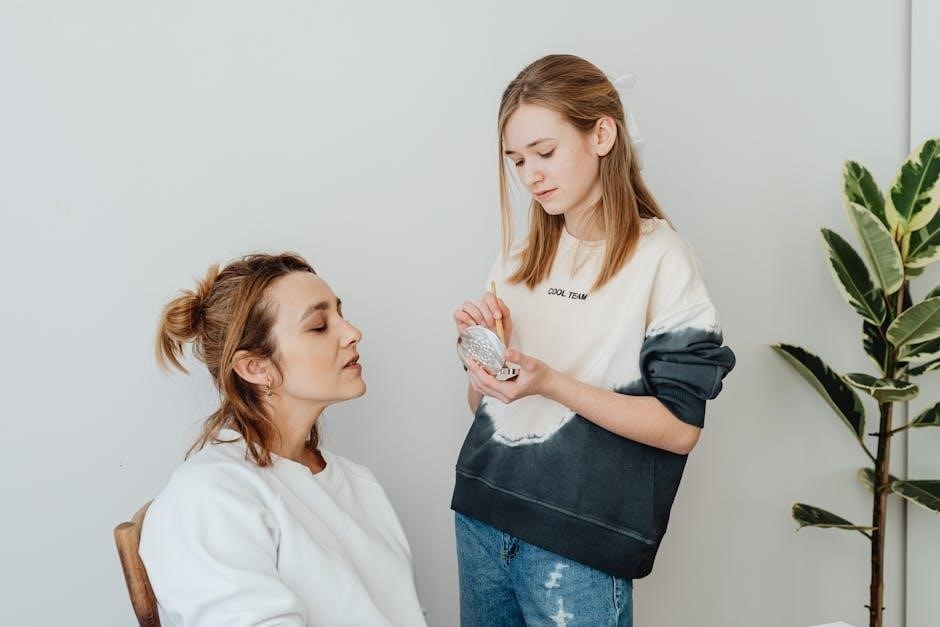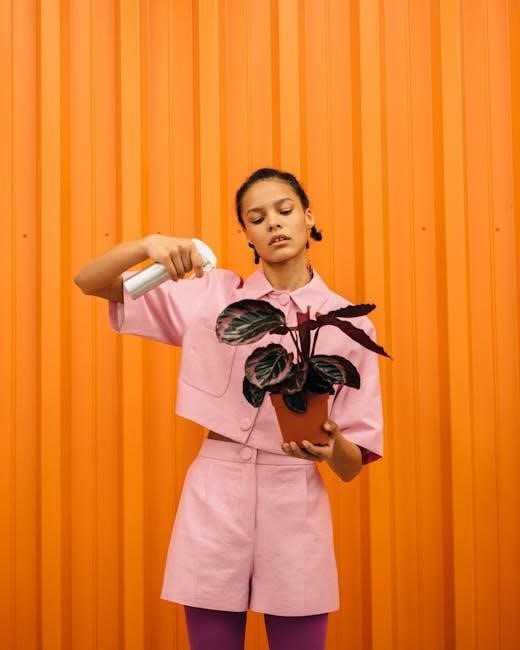Discover the essentials of nurturing indoor plants with a comprehensive indoor plant care guide PDF. Learn light, water, and temperature tips to keep your plants thriving year-round.
Overview of Indoor Plant Care
Indoor plant care involves understanding light, water, temperature, and humidity needs. Most plants thrive in 65–75°F daytime temps and 10°F cooler at night. Water thoroughly, allowing soil to dry slightly between sessions. Fertilize during growth seasons, and observe leaf health for signs of stress. Group plants to boost humidity or use humidifiers for tropical species. Regular pruning and repotting promote healthy growth and prevent root bound issues. Proper care ensures vibrant, thriving indoor greens.

Understanding Your Plant’s Needs
Understanding your plant’s needs is crucial for their survival. Each plant requires specific light, water, and temperature conditions; Observing leaf health helps detect stress early, ensuring optimal growth.
Light Requirements for Indoor Plants
Assess your space’s light conditions to place plants appropriately. Low-light plants like Chinese Evergreen thrive in shaded areas, while bright-light plants such as Fiddle Leaf Fig require direct sunlight. Rotate plants regularly for even growth and avoid drastic light changes. Use sheer curtains to filter intense sunlight for medium-light plants like Snake Plant. Proper light placement ensures vibrant foliage and healthy development.
Watering Indoor Plants
Water indoor plants by soaking the soil thoroughly until water drains from the pot. Avoid overwatering, as it can lead to root rot. Check soil moisture by inserting a finger or chopstick. Reduce watering in winter when plants are dormant. Use room-temperature water to prevent shocking roots. Water low-maintenance plants like succulents sparingly, ensuring soil dries between sessions for optimal health.
Temperature and Humidity for Optimal Growth
Most indoor plants thrive in temperatures between 65–75°F during the day and 5–10°F cooler at night. Maintain consistent humidity, especially for tropical plants, by using humidifiers or grouping plants together. Avoid placing plants near heating vents or drafty areas to prevent stress. Proper temperature and humidity balance ensure robust growth and vibrant foliage.

Choosing the Right Plants for Your Space
Selecting plants that match your space’s light, temperature, and humidity ensures success. Opt for low-maintenance varieties like snake plants or pothos for beginners.
Low-Maintenance Plants for Beginners
Start with hardy, forgiving plants like snake plants, pothos, or ZZ plants. These thrive in low-light conditions, require infrequent watering, and tolerate neglect. Spider plants and succulents are also great for newcomers. They purify the air, grow slowly, and adapt to indoor environments. Perfect for busy schedules, these plants are ideal for building confidence and developing your green thumb.
Selecting Plants Based on Light Conditions
Choose plants that match your space’s light conditions. Low-light areas suit Chinese Evergreen or Pothos, while medium-light spaces thrive with Dracaena or Philodendron. Bright, indirect light is ideal for Bamboo Palms or Bird of Paradise. Assess your room’s light intensity and select plants accordingly to ensure optimal growth and satisfaction. Proper placement enhances both plant health and interior aesthetics.

Soil and Fertilization
Use high-quality potting soil with good drainage and organic matter. Fertilize with a balanced formula during the growing season, avoiding over-fertilization that can harm plants.
Best Potting Soil for Indoor Plants
Choose a high-quality potting soil with good drainage and organic matter. Look for mixes containing peat moss or coconut coir for moisture retention, perlite or vermiculite for aeration, and balanced pH levels. Avoid garden soil, as it can compact and prevent proper drainage. Ensure the soil is specifically designed for indoor plants to promote healthy root growth and nutrient absorption.
Fertilizing Your Indoor Plants
Fertilizing indoor plants is essential for their growth and health. Use a balanced, water-soluble fertilizer during the growing season (spring and summer). Dilute the fertilizer to half the recommended strength to avoid burning roots. Apply monthly, but avoid fertilizing during fall and winter when plants are dormant. Over-fertilizing can harm plants, so follow instructions carefully. Organic options like compost tea can also enhance soil fertility and plant health.

Potting and Repotting
Choose the right pot size and fresh potting soil for healthy root growth. Repot plants when roots outgrow their container, typically during spring. Use proper tools and techniques to ensure success.
When and How to Repot Your Plants
Repot indoor plants when their roots outgrow the container, typically in spring or summer. Choose a pot slightly larger than the current one. Water the plant beforehand to loosen the soil. Gently remove the plant, tease out tangled roots, and trim old or circling roots. Place the plant in fresh potting soil, water thoroughly, and provide optimal conditions for recovery and growth.
Techniques for Successful Repotting
For successful repotting, water the plant a day in advance to soften the soil. Use a pot slightly larger than the current one and fresh, well-draining potting mix. Handle the root ball gently, trimming only damaged or circling roots. Place the plant at the same depth as before, fill gaps with soil, and water thoroughly. Avoid over-handling roots to prevent shock, ensuring a smooth transition for healthy regrowth and stability.

Common Challenges and Solutions
Address pests with neem oil, treat diseases by pruning infected areas, and adjust watering schedules to prevent root rot. Ensure optimal growth by resolving these issues promptly.
Pests and Diseases in Indoor Plants
Common pests like spider mites, mealybugs, and scale can infest indoor plants. Regularly inspect leaves and stems for signs of infestation. Treat with neem oil or insecticidal soap. Overwatering often leads to root rot and fungal diseases. Ensure proper drainage and avoid waterlogged soil. Isolate infected plants to prevent spread and maintain good air circulation for healthy growth.
Preventing Common Problems
Prevent overwatering by using unglazed pots and well-draining soil. Maintain consistent humidity levels and avoid placing plants near drafts or extreme temperatures. Regularly inspect plants for pests and treat early to prevent infestations. Ensure proper light placement to avoid scorched leaves. Fertilize sparingly during the growing season to promote healthy growth and vibrant foliage.
Organic Solutions for Healthy Plants
Use neem oil to naturally combat pests and diseases. A mild soap solution can effectively control insects without harming plants. Add a few drops of ammonia to water for improved foliage color and growth. These organic methods promote healthy plants while avoiding harsh chemicals, ensuring a natural and thriving indoor garden environment.

Pruning and Grooming
Pruning involves trimming plants to maintain shape and health, using tools like scissors or shears. Regular grooming, including leaf cleaning, enhances appearance and promotes healthy growth.
Pruning Tools and Techniques
Use clean, sharp tools like scissors, shears, or pruning saws for precise cuts; Regular pruning keeps plants healthy and looking their best. Remove dead leaves, trim overgrown branches, and shape plants for better growth. Prune during the active growing season to minimize stress. This helps maintain plant health and appearance effectively.
When to Prune Your Indoor Plants
Prune your indoor plants during the growing season (spring and summer) to encourage new growth. Remove dead or damaged leaves and stems to prevent disease. Trim overgrown branches to maintain shape and promote healthy development. Cut back flower stems after blooming to redirect energy to foliage. Regular pruning helps improve airflow and light penetration, keeping your plants strong and vibrant year-round.
Propagation Methods
Explore effective techniques for propagating indoor plants, including stem cuttings, leaf propagation, and division. Ensure proper care post-propagation for healthy growth, as outlined in indoor plant guides.
How to Propagate Indoor Plants
Propagate indoor plants through stem cuttings, leaf propagation, or division. Choose healthy sections, ensure proper rooting conditions, and maintain consistent moisture. Provide bright, indirect light and avoid over-watering. Rooting hormone can enhance success. Monitor growth and transfer to individual pots once established. Detailed steps are available in indoor plant care guides for optimal results.
Caring for New Plants After Propagation
After propagation, provide new plants with bright, indirect light and moderate watering. Maintain optimal temperatures and humidity. Avoid over-handling to prevent stress. Fertilize lightly once roots establish. Monitor growth and adjust care as needed. Detailed guidance for nurturing young plants is available in indoor plant care guides, ensuring healthy development and robust growth.
Seasonal Care Tips
Adapt your plant care strategies to seasonal changes. Adjust light, water, and temperature to match the environment, ensuring optimal growth and health throughout the year.
Winter Care for Indoor Plants
During winter, reduce watering as plants grow slower. Use humidifiers to combat dry air and avoid placing plants near drafts or heating vents. Prune less frequently, as growth slows, and fertilize sparingly. Maintain temperatures between 65-75°F during the day and slightly cooler at night. Ensure plants receive sufficient light, possibly supplementing with grow lights if natural light is scarce.
Summer Care for Indoor Plants
In summer, indoor plants thrive with increased light and warmth. Water more frequently, but avoid overwatering to prevent root rot. Fertilize regularly to support growth. Keep plants away from direct sunlight to avoid overheating, using sheer curtains if necessary. Maintain temperatures between 65-75°F. Humidity levels can drop, so mist leaves or use a humidifier. Monitor for pests, as warmer months increase their activity, and treat promptly if necessary.

Monitoring Plant Health
Regularly inspect your plants for vibrant leaves and strong stems. Watch for signs of stress, like yellowing leaves or pests. Adjust care routines as needed to ensure optimal growth and address any issues promptly for thriving indoor plants.
Observing Leaf Health and Color
Monitor your plants’ leaves regularly for vibrant colors and strong structures. Yellowing leaves may indicate overwatering or nutrient deficiencies, while browning tips could signal excessive fluoride or dry air. Ensure proper light exposure, as insufficient light can dull foliage. Adjust watering and fertilization routines based on leaf health to maintain robust growth and prevent pests or diseases from taking hold.
Creating a Plant Care Schedule
Develop a consistent routine to ensure your plants thrive. Schedule watering based on soil moisture, typically every 1-2 weeks, and fertilize monthly during the growing season. Rotate plants for even light exposure and prune as needed. Track seasonal changes, adjusting care for winter dormancy and summer growth spurts. A well-organized plan helps maintain healthy, vibrant plants year-round.

Creating a Plant-Friendly Environment
Ensure optimal conditions by maintaining proper humidity levels and avoiding extreme temperatures. Use humidifiers for tropical plants and place them away from drafts. Optimize light placement for balanced growth, such as east or west-facing windows. Group plants together to naturally increase humidity and create a thriving indoor ecosystem.
Grouping Plants to Increase Humidity
Grouping plants together creates a microclimate that maintains humidity levels. Plants release moisture through transpiration, benefiting neighboring plants. This method is especially effective for tropical species. Place plants on a tray filled with water and pebbles to enhance humidity further. Regular misting and using a humidifier can also support this natural process, ensuring vibrant and healthy growth in indoor spaces.
Using Humidifiers for Tropical Plants
Humidifiers are essential for tropical plants that thrive in high-humidity environments. These devices maintain optimal moisture levels, preventing leaf curl and dryness. Place the humidifier near plant groupings to maximize benefits. Regular monitoring ensures the air doesn’t become overly saturated, which can lead to mold growth. This method complements natural transpiration, creating a balanced ecosystem for lush, healthy tropical plants indoors.
Optimizing Light Placement
Position plants according to their light requirements. Place low-light plants like snake plants or pothos in shaded areas, while sun-loving species such as succulents or citrus trees thrive near bright windows. Rotate plants seasonally to adapt to changing sunlight patterns, ensuring even growth and preventing lopsided development. Proper light placement enhances photosynthesis, promoting vibrant colors and robust health in your indoor plants.
Advanced Tips for Experienced Growers
Explore expert techniques like plant rotation for balanced growth and collecting rare species. Refine your skills with advanced pruning methods and experiment with unique propagation strategies.
Plant Rotation for Even Growth
Rotate plants regularly to ensure even light distribution, promoting symmetrical growth. This technique prevents lopsided development and encourages balanced foliage. Rotate plants every 1-2 weeks, especially those in low-light conditions, to maximize exposure to available light sources. Consistent rotation mimics natural outdoor growth patterns, leading to healthier, more aesthetically pleasing indoor plants. This simple practice enhances overall plant structure and appearance.
Collecting Rare and Exotic Plant Varieties
Enthusiasts seeking unique additions to their indoor spaces often pursue rare and exotic plant varieties. These plants, often sourced from specialized nurseries or online communities, offer distinctive features and beauty. Ensure sustainability by obtaining plants legally and ethically. Research specific care requirements, as these plants may need tailored conditions like high humidity or filtered light. Invest in proper equipment, such as humidifiers or grow lights, to replicate their natural habitats. Regularly monitor temperature fluctuations and watering needs, as exotic plants can be more sensitive. Experiment with propagation methods like cuttings or division to share or expand your collection. Always check local regulations before acquiring rare species to avoid legal issues. With dedication and proper care, these plants can thrive and become standout pieces in your indoor garden.




About the author